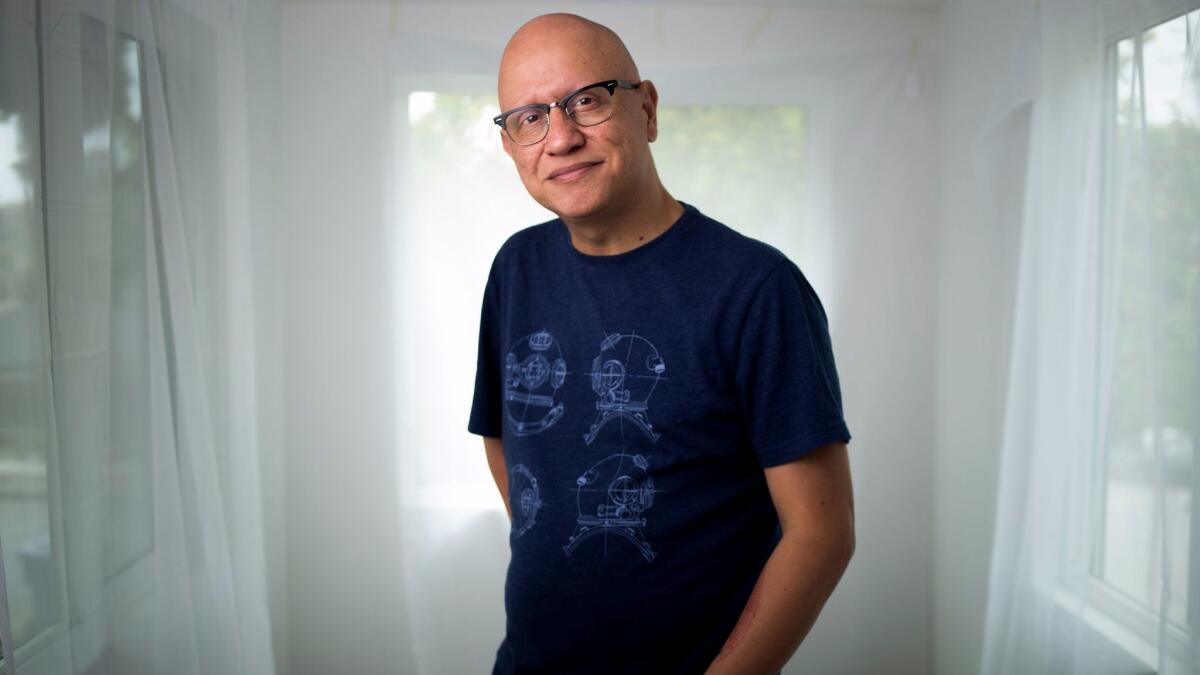Trump wants immigrants to ‘share our values.’ They say assimilation is much more complex
- Share via
Growing up in La Puente in the 1980s, Alex Espinoza was a typical child of the Reagan era. He collected “Star Wars” action figures and played with Rubik’s Cube.
But Espinoza was Mexican, born in Tijuana and brought to the United States by his mother when he was about 2 years old. He downplayed his Mexican roots to fit in. At the time, it seemed the worst thing in the world for a boy to be labeled as “a TJ” — literally someone from Tijuana, but also shorthand for an unassimilated Mexican.
“I grew up preferring the taste of a Big Mac over a burrito. I grew up preferring the taste of tuna noodle casserole over menudo,” he said. “Until I went to Mexico as a grad student, Mexico was this kind of static in the background.”
Three decades later, President Trump has sparked a new debate over immigration and assimilation that has Espinoza and many others reflecting on what it means to blend into American culture.
Share your thoughts: What does it mean to be “American”?
While much has been made about Trump’s harsh talk of deporting those here illegally, the president’s comments about the need for immigrants to fully embrace American culture has renewed a long-running debate that dates back generations.
“Not everyone who seeks to join our country will be able to successfully assimilate,” President Trump said in a campaign-trail speech in which he called for new immigrants to pass an “ideological certification to make sure that those we are admitting to our country share our values and love our people.”
In one Republican debate, Trump declared that “we have a country where, to assimilate, you have to speak English … This is a country where we speak English, not Spanish.”
Though Espinoza and others might disagree with Trump’s policies on immigration, they say discussions about assimilation get to the heart of a balancing act all immigrants face: being American while preserving a strong sense of where they came from.
“Have I been assimilated? I don’t know,” said the 45-year-old director of the graduate creative writing and literary arts program at Cal State Los Angeles. “Some people will probably say yes — look at how I dress and speak and where I’m educated. And some people will say no — he speaks Spanish and has a Mexican passport.”
When he went to Mexico for the first time as an adult, the way he spoke, tripping over some Spanish words, instantly pegged him as American. Espinoza is a permanent legal resident but believes that even if he became a U.S. citizen he would never be considered “fully American” by some people.
“Even if I started right now speaking in a Southern drawl and listening to country music, I’m still going to be Mexican,” he said. “My skin is still going to be a certain shade. Assimilation is not this thing where it’s like, OK, I’m one of you.”
Though people often define assimilation in starkly different ways, a Pew Research Center survey released in February showed that 92% of Americans say it’s at least somewhat important for a person to speak English to be considered “truly American,” with 70% saying it’s “very” important.
More than 80% of the survey’s respondents believed that sharing American culture and traditions is at least somewhat important to national identity.
“We at least have absorbed and believe this national narrative that we are a nation of immigrants,” said Bruce Stokes, director of global economic attitudes at Pew. “But ... it’s not so easy once you get into some of the details of diversity. People are saying, ‘This is good for the country, but it’s not good for me,’ and that ‘Diversity is good, but I actually I don’t like the fact that someone speaks Spanish in the store I go to.’”

These questions have dominated immigrant communities dating back to the 19th century, when the Italians, Irish, Germans, Chinese and other groups faced questions about whether they were true Americans.
The foreign-born share of the U.S. population has quadrupled in the five decades since the establishment of the 1965 Immigration and Nationality Act, which ended a quota system based on national origin that favored white European immigrants. In 1960, 9.7 million foreign-born residents were living in the U.S. In 2014, there were 42.2 million, according to census data and the Pew Research Center.
Kevin Solis, who works for the immigration advocacy group Dream Team LA, said politicians’ statements about assimilation just add fuel to an already sensitive subject.
“When you say, ‘They need to assimilate,’ you’re already beginning with the false notion that they don’t want to, that they’re coming here as an invading force,” he said. “It’s coded in the sense that these are ‘other’ people, foreigners who want to do harm to our nation, and that’s not the case.”
Jim Chang, an information systems specialist from Irvine, recalled meeting with one of his son’s teacher; she kept repeating what he was saying.
“I know he was repeating, you know, saying it more than once because she was worried I didn’t understand,” Chang, 53, said.
Though he spoke English fairly well and understood it even better, Chang said his Korean accent meant he would always stick out.
“It doesn’t matter if you have 12 years or 20 years in the U.S. If they hear us sound a little different, they judge,” he said.
That’s something he said he believes his son, a fifth-grader, shouldn’t have to face. Chang speaks Korean to him, but his son, Jimmy, responds in English.
“I realize that we don’t plan to return to live in Korea. We belong in California now,” Chang said.
But Carmen Fought, a linguistics professor at Pitzer College, said that everyone has an accent regardless of how well they speak English. Whether it’s the Cajun or so-called “Minnesota nice” or “Bronx” or other accent not quite on the radar of American pop culture, everyone in the U.S. speaks with an accent, she said.
Not all accents, however, are perceived as equally American.
“A way of speaking that’s associated with a group that’s stigmatized is also going to be stigmatized,” Fought said. “There’s also going to be racism and prejudice against that way of speaking.”
Karen, a 24-year-old honor student at Cal State Fullerton, is an aspiring certified public accountant. She volunteers for the IRS — where her ability to speak Spanish is a major asset — helping low-income people fill out their taxes.
The night Trump was elected, Karen — a Deferred Action for Childhood Arrivals, or DACA, recipient who asked that her last name not be used because she fears deportation — suddenly felt as if she stood out even though she was an infant sleeping in the back seat of a car when she was brought to the U.S. illegally from Mexico.
Karen hasn’t been back to Mexico since then but grew up in the overwhelmingly Latino community of Huntington Park, watching Spanish-language television with her grandmother and working in a Mexican restaurant.
Moving to Orange County for college was like moving to a different world, Karen said. At least until Trump’s election, she felt that she was safer as a college student than her parents, who have labor-oriented jobs.
Her younger brother is a DACA recipient also, and she had him move in with her so they could remove their parents’ address from their federal forms.
“Sometimes I feel like I don’t belong anywhere,” she said. “In Mexico, I would be seen very differently because of my accent. It’s like, god, what do I do? If I were to go back, I wouldn’t have anything back there.”
“On the one side, the Hispanics tell you, ‘You’re way too American.’ On the other, you’ll have the Americans telling you you’re too Hispanic. It’s hard to be in the middle.”
“What makes me American? It’s not only the 24 years of my life,” she said. “It’s that this is all I know.”
To read the article in Spanish, click here
Twitter: @haileybranson
Times staff writer Anh Do contributed to this report.
ALSO
Boy, 8, and teacher slain in San Bernardino school shooting; gunman kills himself
Trump’s border wall will get its start in San Diego County
Charter schools are expanding where they aren’t needed — especially in Los Angeles, new report says
More to Read
Sign up for Essential California
The most important California stories and recommendations in your inbox every morning.
You may occasionally receive promotional content from the Los Angeles Times.











